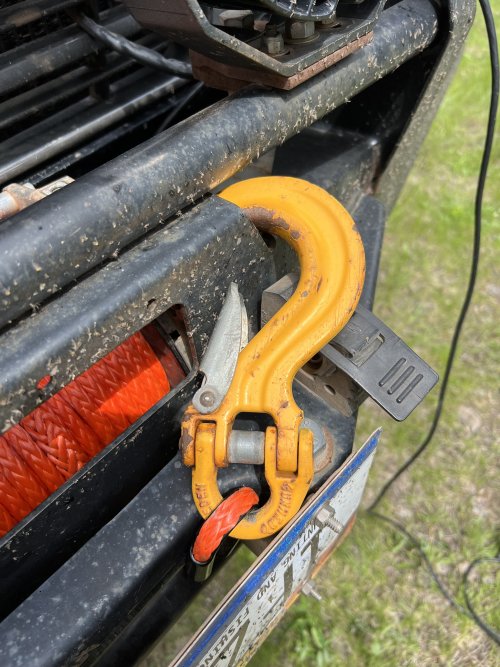Why do you want 7/16”? 3/8” is plenty strong enough for a 12,000lb winch let along the a 9500.
You are using an out of date browser. It may not display this or other websites correctly.
You should upgrade or use an alternative browser.
You should upgrade or use an alternative browser.
Alternative synthetic rope?
- Thread starter LARGEONE
- Start date
LARGEONE
Rising Sun Member
LARGEONE
Rising Sun Member
Seems like the generic was just as strong, but tough to test longevity of long term use. Also hard to trust that every batch will yield the same strength?
@Corbet I was also thinking that my winch would burn up before breaking rope, but I bet you could have some other dynamic factors that could push the forces well above the winch capacity.
@Corbet I was also thinking that my winch would burn up before breaking rope, but I bet you could have some other dynamic factors that could push the forces well above the winch capacity.
@Corbet I was also thinking that my winch would burn up before breaking rope, but I bet you could have some other dynamic factors that could push the forces well above the winch capacity.
3/8” Amsteel is already well beyond the strength of a 3/8” steel rope. Breaking is like 18K. I can’t see how you’d exceed that during responsible recovery techniques. I’ve abused mine. Completely stalled a 12K warn with a snatch block. Nearly pulled that 12” tree out of the ground. Never once did I think I needed a larger diameter rope when I replaced it last year.
DaveInDenver
Rising Sun Ham Guru
I have 5/16” Amsteel on my XD9000 and haven’t broken it but I’ve stalled it on a mini truck and now Taco maybe a couple of times so it’s not seriously stressed.Why do you want 7/16”? 3/8” is plenty strong enough for a 12,000lb winch let along the a 9500.
The key is knowing it is not counterfeit and as long as you know that then it’s statistically proven to meet specs. Ships and pro riggers rely on the numbers so you can too. There is no reason to use 7/16”, really.
The hands down best way IMO is go2marine bulk and rig it yourself. You know it’s legit and that it’s done right and isn’t expensive.
LARGEONE
Rising Sun Member
I believe I am landing here. Is there a preferred way to attach the thimble or whatever end I decide on? Deep taper with stitching, or bramble (or whatever it’s called)? I’ve watched videos of both but not sure I understand which is better?
Also…I’m thinking of 65’ on the winch and 65’ in the truck. Is there a better ratio that I should be thinking of? (I.e. less on the winch and more in the truck? Or vice versa?)
Also…I’m thinking of 65’ on the winch and 65’ in the truck. Is there a better ratio that I should be thinking of? (I.e. less on the winch and more in the truck? Or vice versa?)
Inukshuk
Rising Sun Member
@Corbet3/8” Amsteel is already well beyond the strength of a 3/8” steel rope. Breaking is like 18K. I can’t see how you’d exceed that during responsible recovery techniques. I’ve abused mine. Completely stalled a 12K warn with a snatch block. Nearly pulled that 12” tree out of the ground. Never once did I think I needed a larger diameter rope when I replaced it last year.
Some things are facts. Some things are opinions. Some things are “best practices.” I’m writing to the people asking the questions here. You have developed your opinions based on your experiences. For people who don’t have your experiences and are looking to develop their own opinions, I’m sharing what I’ve been trained there is empirical consensus are best practices. I can give you a whole bunch of reasons or opinions, but that’s a whole lot more than I can do at the moment and you’re not asking for recommendations.
I believe I am landing here. Is there a preferred way to attach the thimble or whatever end I decide on? Deep taper with stitching, or bramble (or whatever it’s called)? I’ve watched videos of both but not sure I understand which is better?
Also…I’m thinking of 65’ on the winch and 65’ in the truck. Is there a better ratio that I should be thinking of? (I.e. less on the winch and more in the truck? Or vice versa?)
All spices are held in place under load by the bury. The length of the bury as recommended by the manufacturer. Longer is not better. Proper depth give the proper load capacity. Amsteel Blue is a product of Sampson rope and they publish all of that on their website. Amsteel Blue most basic eye is a 12 Strand Class II Eye Splice https://www.samsonrope.com/resources/how-to-splice-rope
A bury must be properly tapered. An untapered (straight cut) end causes a bend in the rope. This weakens it. This bend is where they typically fail. A proper taper doesn’t cause any appreciable derating.
The purpose of a lock stitch or a Brummel Lock is to keep the berry from creeping out when the rope is not under load. Neither have any effect whatsoever on holding rope under load although a Brummel Lock alone will hold more than a stitch. Having used both I’m now preferring the Brummel lock.
Sounds to me like we should do another splicing gathering like we did at Damon’s house a couple years ago. I’d love to host that for the club. It has to be after I finish this project of mine.
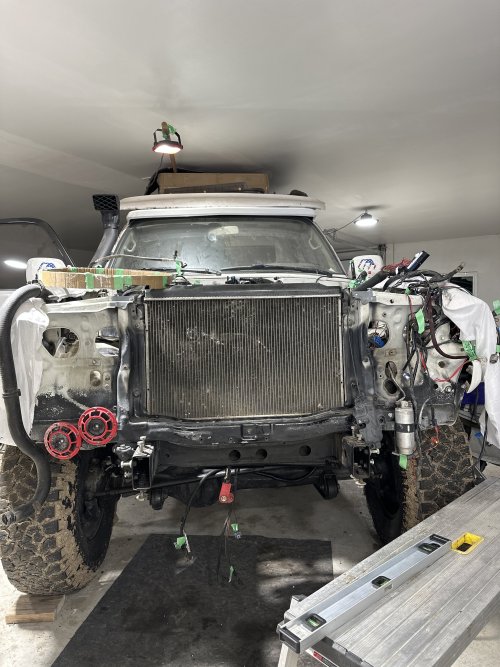
Last edited:
Inukshuk
Rising Sun Member
For what it’s worth, climbers use a 10 to 1 safety factor in their equipment. So a whole lot of people with a whole lot of experience have decided overhead lifting should have a 5 to 1 safety factor and climbing should have a 10 to one safety factor and for winching, which is moving loads irregularly over an uneven surface people are regularly considering equipment with as low as a two to one safety factor.
Food for thought.
Also…I’m thinking of 65’ on the winch and 65’ in the truck. Is there a better ratio that I should be thinking of? (I.e. less on the winch and more in the truck? Or vice versa?)
I like to have more length on the spool than the length of my extension/s. If I’m pulling with the extension and I’ve re-spooled my drum rope I want it to reach my anchor once I unspool it and remove the extension. Hope that description made sense.
Because you always have a few wraps on the spool and it takes some rope length to make the bury on the business end I’d say and extra 15’ is safe. Personally I have more. I run a full spool worth of rope which deviates from what Daniel is saying about proven techniques. Shorter length of spooled rope to have less layers and therefore greater pulling power available for shorter pull distances.
Daniel and I have debated this topic many times. I except that his way is correct and he accepts that my way works for me based on my personal experiences which have historically been long pull solo recoveries.
Last edited:
Inukshuk
Rising Sun Member
Exactly.Daniel and I have debated this topic many times. I except that his way is correct and he accepts that my way works for me based on my personal experiences which have historically been long pull solo recoveries.
I won’t go so far to say my suggestion is “correct.” It’s a good practice that’s going to work well for a lot of people in a lot of conditions, but not everybody.
I’ve heard people in the heavily forested Northeast talk of running 40 feet of line so they can get to that first layer very quickly.
You’ll probably lose about 2 feet of length making the eye splice.
I’ve never measured how many feet it takes to get the 7 to 11 wraps you leave in the first layer of the drum. I’ll have to do that.
This is why these kind of discussions are great. We talk about the “why.”
BritKLR
Vice Commander
Sounds to me like we should do another splicing gathering like we did at Damon’s house a couple years ago. I’d love to host that for the club. It has to be after I finish this project of mine.
Interested. Come this summer, I'd offer up the ATC shop for the gather/class if people wish to drive that far.
Inukshuk
Rising Sun Member
Perfect!Interested. Come this summer, I'd offer up the ATC shop for the gather/class if people wish to drive that far.
LARGEONE
Rising Sun Member
I’m digging this discussion as well. Thanks for participating. I would totally be down with a splicing event if I havent already done mine by then. I really want to get my 80 back to wheeling this year and am excited about the rebuilt winch and how easy it is to engage and disengage now. Looks like I’m going to have to buy a new rear bumper for the 80 so I’ll also have to research that and get one on order soon.
What are you guys running on the end of the synthetic rope to protect the end and also to keep from damaging the aluminum fairlead? Seems like the Factor55 type of end forces you to use specific attachment types? Anyone still running hooks with synthetic?
BTW…I was planning on total 15’ extra for the three burried ends (two for extension and one for winch rope).
What are you guys running on the end of the synthetic rope to protect the end and also to keep from damaging the aluminum fairlead? Seems like the Factor55 type of end forces you to use specific attachment types? Anyone still running hooks with synthetic?
BTW…I was planning on total 15’ extra for the three burried ends (two for extension and one for winch rope).
Last edited:
Inukshuk
Rising Sun Member
Hooks are fine. But if you have to buy something anyway, really no point to buy a hook. I will always be connecting with a screw pin bow or soft shackle. In such a "closed winching" setup, a hook adds nothing and my be detrimental.
I have a soft loop with removable chafe guard. I may change to one of those simple splice on eyes. Mine resides behind a removable license plate so it is protected from front road debris hits by the plate and weather generally by the chafe guard.
Roller fairleads are best - esp if deep set in an ARB bumper. One key enemy of synthetic rope is heat. Friction generates heat. Drag over Hawse = friction. Heat = damaged rope. Damaged rope reduces strength. (refer back to Safety Factor comments above). Everything you may have heard about why to use Hawse for synthetic is wrong. Steel Hawse are used for steel rope in some settings. Fact, not opinion. Will Hawse usually work, yes. Is it best practice, no. Is it bad? Not if used responsibly.
If you have a hook, stow it against the fairlead, not hooked over bumper (sorry Corbet is wrong here but his hook is a nice one. Rated. )
but his hook is a nice one. Rated. )
I have a soft loop with removable chafe guard. I may change to one of those simple splice on eyes. Mine resides behind a removable license plate so it is protected from front road debris hits by the plate and weather generally by the chafe guard.
Roller fairleads are best - esp if deep set in an ARB bumper. One key enemy of synthetic rope is heat. Friction generates heat. Drag over Hawse = friction. Heat = damaged rope. Damaged rope reduces strength. (refer back to Safety Factor comments above). Everything you may have heard about why to use Hawse for synthetic is wrong. Steel Hawse are used for steel rope in some settings. Fact, not opinion. Will Hawse usually work, yes. Is it best practice, no. Is it bad? Not if used responsibly.
If you have a hook, stow it against the fairlead, not hooked over bumper (sorry Corbet is wrong here
My fairlead rollers are delrin so a good chance I damage them if I snug up my hook. Plus I have a license plate mount that squeezes between the rollers. I hook it up high to prevent any damage on rocks that could occur if I hooked it below the bumper. Daniel what’s your reasoning for avoiding what I do?
Last edited:
LARGEONE
Rising Sun Member
If my steel rollers are smooth, can I use them with synthetic? That would save me $100+
I thought I read that the rollers can pinch the rope?
I thought I read that the rollers can pinch the rope?
DaveInDenver
Rising Sun Ham Guru
@LARGEONE
I run a spliced in safety thimble on my line with Delrin rollers in a plain old Warn fairlead frame.
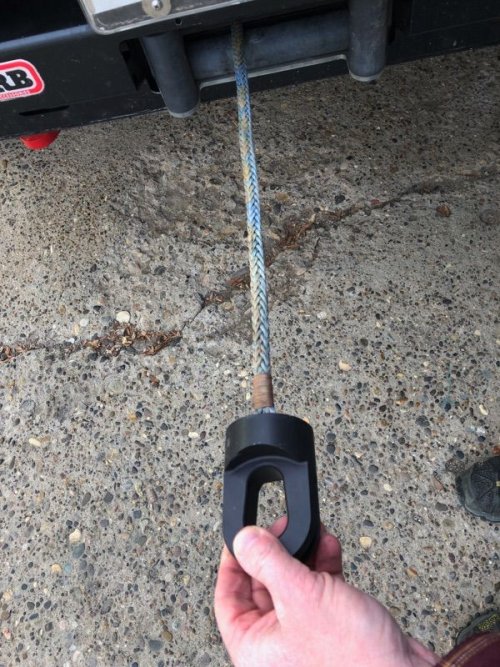
It's an opinion but I prefer rollers over a hawse. I've never found an angle where a loaded winch line could pull itself into the gap between rollers. To get it to fall between rollers you'd have to push the line into them intentionally in absurd, unrealisitic ways.
You can use steel rollers with synthetic rope but only if the rollers brand new or have not previously been used with steel. You may be able to smooth them but there's some risk there. Not absolutely impossible but be mindful. BTW this is true of delrin, too. Delrin rollers like these Viking Corbet and I use could also be used with steel if you so desired but once you do you should not use them with synthetic after. The risk is worn in sharp ridges or embedded slivers or any rust (rust starting once the chrome is scratched is the main PITA I find with steel rollers) that will cut the synthetic.
On the flip side you could in theory use hawse steel fairleads with steel rope, nothing is written in stone that steel rope has to use rollers, synthetic uses hawse. Using hawse with steel rope is tough since the surfaces don't like to run over smoothly while synthetic rope will slide pretty readily over a smooth surface so it isn't working against you too much. It has to be aluminum with synthetic rope mainly for heat dissipation.
I don't have a problem with hooks but I like the way Daniel thinks here with all closed connections. This thimble is cheap and the way it's spliced means you don't have to worry about it's rating itself. The main thing with a spliced in thimble is that it has a radius that is sufficient to prevent too tight of a bend on the rope and that it can resist crushing. I like having a thimble over soft eyes primarily for the physical protection it gives the rope. If I ran a soft eye I'd feel better having a kevlar sleeve over it. It's not so much rigging itself I worry about but being peppered with rocks on the highway and dragged or snagged on rocks and shopping carts.
If you go with a Factor55 hook you have a choice. One type they sell is spliced in like this but the more fancy ones all you need is to splice the rope with a regular thimble or if you want a soft eye they have an insert you can use if you use.
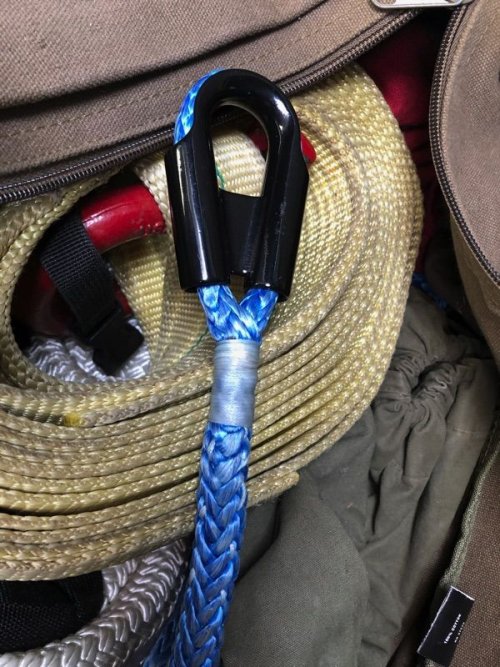
Those terminations are not spliced in directly but mounted after with a pin that drops in through the thimble. This gives you options to change it out or go back to a hook or even just use the thimble directly.
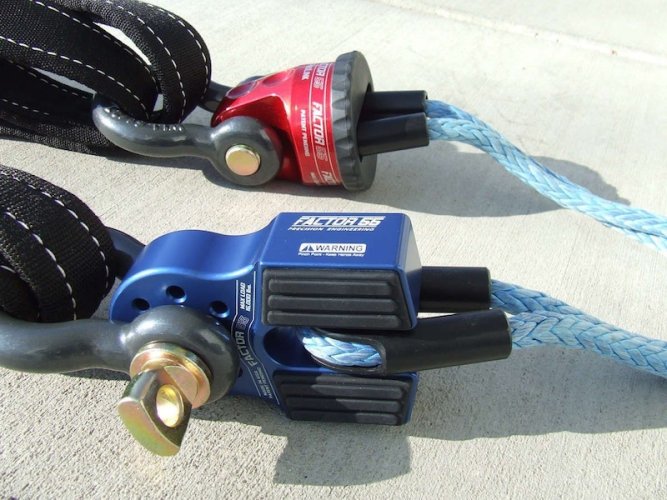
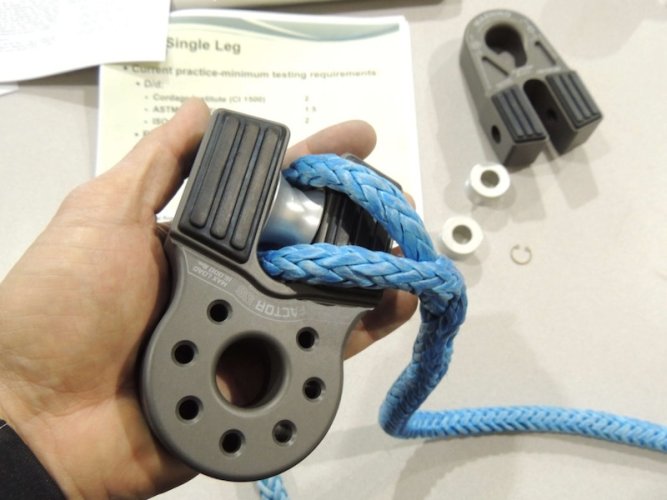
I don't know if you're aware of this thread, but there's a ton of pertinant discussion
I run a spliced in safety thimble on my line with Delrin rollers in a plain old Warn fairlead frame.

It's an opinion but I prefer rollers over a hawse. I've never found an angle where a loaded winch line could pull itself into the gap between rollers. To get it to fall between rollers you'd have to push the line into them intentionally in absurd, unrealisitic ways.
You can use steel rollers with synthetic rope but only if the rollers brand new or have not previously been used with steel. You may be able to smooth them but there's some risk there. Not absolutely impossible but be mindful. BTW this is true of delrin, too. Delrin rollers like these Viking Corbet and I use could also be used with steel if you so desired but once you do you should not use them with synthetic after. The risk is worn in sharp ridges or embedded slivers or any rust (rust starting once the chrome is scratched is the main PITA I find with steel rollers) that will cut the synthetic.
On the flip side you could in theory use hawse steel fairleads with steel rope, nothing is written in stone that steel rope has to use rollers, synthetic uses hawse. Using hawse with steel rope is tough since the surfaces don't like to run over smoothly while synthetic rope will slide pretty readily over a smooth surface so it isn't working against you too much. It has to be aluminum with synthetic rope mainly for heat dissipation.
I don't have a problem with hooks but I like the way Daniel thinks here with all closed connections. This thimble is cheap and the way it's spliced means you don't have to worry about it's rating itself. The main thing with a spliced in thimble is that it has a radius that is sufficient to prevent too tight of a bend on the rope and that it can resist crushing. I like having a thimble over soft eyes primarily for the physical protection it gives the rope. If I ran a soft eye I'd feel better having a kevlar sleeve over it. It's not so much rigging itself I worry about but being peppered with rocks on the highway and dragged or snagged on rocks and shopping carts.
If you go with a Factor55 hook you have a choice. One type they sell is spliced in like this but the more fancy ones all you need is to splice the rope with a regular thimble or if you want a soft eye they have an insert you can use if you use.

Those terminations are not spliced in directly but mounted after with a pin that drops in through the thimble. This gives you options to change it out or go back to a hook or even just use the thimble directly.


I don't know if you're aware of this thread, but there's a ton of pertinant discussion
Last edited:
Inukshuk
Rising Sun Member
So just don’t “crank” it down which I don’t. But I understand what you’re saying.

